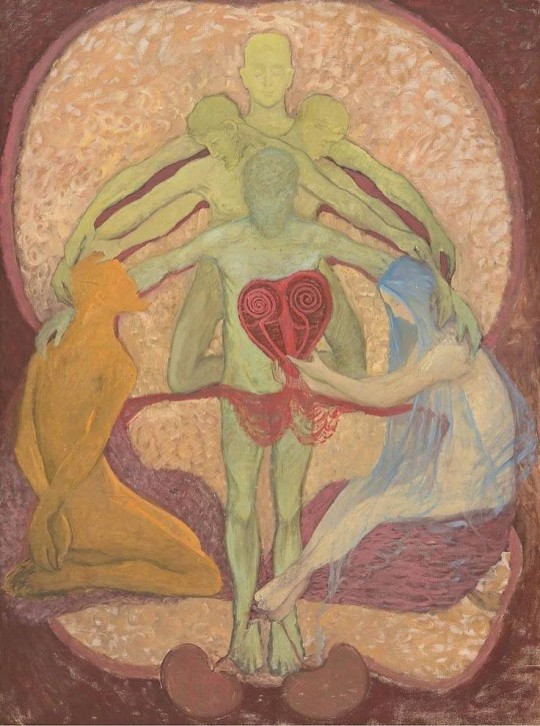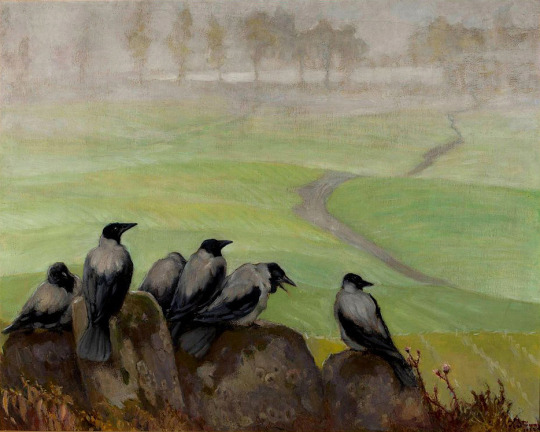#theosophy
Text

The Rose, Nr4, by Hilma af Klint, 1907.
#hilma af klint#female artists#the rose#symbolism#art#painting#spiritualism#heart#transcedence#abstract art#mysticism#theosophy
3K notes
·
View notes
Text

Emma Kunz (1892-1963) — Work No. 333 [pencil and oil crayon on millimetre graph paper, no date]
239 notes
·
View notes
Text

Astral Plane IV
Digital art
2024
(Lic.: CC BY-NC-ND 3.0)
#occult art#dark art#noughtlux#sepia#circle#rays#theosophy#esotericism#electricity#ἤλεκτρον#tulpa#སྤྲུལ་སྐུ་#light#metaphysics#digital art#artists on tumblr#art#CC BY NC ND
199 notes
·
View notes
Text
New Age is a poisoned chalice.
MASSIVE CW for racism and genocide up ahead.
So, New Age ultimately goes back to Theosophy, which was primarily founded by Helena Blavatsky. Here's a paragraph Blavatsky wrote herself in her own book The Secret Doctrine:
Mankind is obviously divided into God-informed men and lower human creatures. The intellectual difference between the Âryan and other civilized nations and such savages as the South Sea Islanders, is inexplicable on any other grounds. No amount of culture, no generations of training amid civilization, could raise such human specimens as the Bushmen, the Veddhas of Ceylon, and some African tribes, to the same intellectual level as the Âryans, the Semites, and the Turanians so-called. The “Sacred Spark” is missing in them, and it is they who are the only inferior races on the Globe, now happily— owing to the wise adjustment of Nature which ever works in that direction—fast dying out. Verily mankind is “of one blood,” but not of the same essence . We are the hot-house, artificially quickened plants in Nature, having in us a spark, which in them is latent.
This is the kind of sentiment the New Age movement came out of, and it's not any better today - New Agers are still simping for genocide, whether they're looking forward to people dying from climate change or eagerly awaiting the day Trump and his loyalists enact a second Holocaust. You don't have to dig very far at all to find videos and blogs expressing these very sentiments.
New Agers, by the way, are the people pushing things like:
-Soulmates and twin flames
-The Law of Attraction/Law of Assumption/Manifestation
-"Low vibrational frequency" vs. "high vibrational frequency"
-Karmic debt
-DNA upgrades/DNA activation/light code activation
-Ascension to 5D
-The existence of Atlantis, Lemuria, and Mu
-Ancient aliens
-Starseeds
So yeah, watch out for this stuff (it's unfortunately all too common on witchblr and WitchTok), and be aware that though it might look harmless on the surface, it's all rotten underneath.
#helena blavatsky#theosophy#genocide#racism#occult#occultism#esotericism#witchblr#witchtok#spirituality#spiritual eugenics#the secret doctrine
969 notes
·
View notes
Photo

Kazimierz Stabrowski - Crows Council of Seniors.
762 notes
·
View notes
Text


We're Serious. It's Publisher's Binding Thursday!
We came across this striking publisher's cloth binding on an 1895 book on theosophy. The front is decorated with eye-catching symbols of theosophy, but the back cover also bears a serious looking fellow with a serious sort of message.
Sinclair, Marie, Countess of Caithness. Serious letters to serious friends. 2nd ed. London, C.L.H. Wallace, 1888.
67 notes
·
View notes
Text

Madame Blavatsky
#books#history#literature#religion#theology#mysticism#esotericism#theosophy#theosophical society#madame blavatsky#helena blavatsky#blavatsky#occult#occultism#religious aesthetic#aesthetic#ldr#lana del rey#ldr aesthetic#coqeutte#cutesy
28 notes
·
View notes
Photo

Disclaimer: This is just a joke, I don’t actually think any of these paths are evil. The axes are more RHP/LHP and Conventional/Edgy.
#occult memes#occult#occultism#memes#hermetic order of the golden dawn#wicca#thelema#theosophy#chaos magic#qulipoth#solomonic magic#demonolatry#ceremonial magic#satanism#alignment chart
265 notes
·
View notes
Text
The first duty of love is to listen.
Paul Tillich, Source Unlisted.
#philosophy tumblr#philoblr#german philology#philosopher#theosophy#paul tillich#love#meta ethics#existentialism#listening#dark academia#life quotes
49 notes
·
View notes
Text
youtube
Freemason Sufi Druid | Robert Graves
Graves turned down a CBE in 1957 and was among a shortlist of authors considered for the 1962 Nobel Prize in Literature, losing out to John Steinbeck. And while mostly remembered as an author and poet, his contributions to the comparative examination retracing the overlapping commonalites shared and missing links in between Western and Eastern esotericism, hermeticism, and mysticism are not as widely cited or as commonly known as those of Manly P. Hall, Madame Blavatsky, Aleister Crowley, G.I Gurdjieff, P.D Ouspensky, Robert Anton Wilson, Rudolph Steiner, and Alan Watts but nevertheless stand on their own merit.
#western esotericism#eastern esotericism#western hermeticism#eastern hermeticism#hermeticism#esotericism#occultism#mysticism#occult#esoteric#fraternal order#robert graves#sufism#freemasonry#manly p. hall#aleister crowley#Madame Blavatsky#rudolph Steiner#theosophy#anthroposophy#p.d ouspensky#g.i gurdjieff#gurdjieff#alan watts
43 notes
·
View notes
Text
WHO IS LUCIFER?
“Lucifer,” is the pale morning-star, the precursor of the full blaze of the noon-day sun—the “Eosphoros” of the Greeks. It shines timidly at dawn to gather forces and dazzle the eye after sunset as its own brother ‘Hesperos’—the radiant evening star, or the planet Venus. No fitter symbol exists for the proposed work—that of throwing a ray of truth on everything hidden by the darkness of prejudice, by social or religious misconceptions; especially by that idiotic routine in life, which, once that a certain action, a thing, a name, has been branded by slanderous inventions, however unjust, makes respectable people, so called, turn away shiveringly, refusing to even look at it from any other aspect than the one sanctioned by public opinion. Such an endeavour then, to force the weak-hearted to look truth straight in the face, is helped most efficaciously by a title belonging to the category of branded names.
[…]
So deeply rooted, indeed, is this preconception and aversion to the name of Lucifer—meaning no worse than “light-bringer” (from lux, lucis, “light,” and ferre “to bring”).
|||||||||||||||||||||||||||||||||||
QUEM É LÚCIFER?
“Lúcifer” é a pálida estrela da manhã, a precursora do brilho total do sol do meio-dia — o “Eosphoros” dos gregos. Ela brilha timidamente ao amanhecer para reunir forças e deslumbrar os olhos após o pôr do sol como seu próprio irmão ‘Hesperos’ — a radiante estrela da noite, ou o planeta Vênus. Não existe símbolo mais adequado para o trabalho proposto — o de lançar um raio de verdade sobre tudo o que está oculto pelas trevas do preconceito, pelos equívocos sociais ou religiosos; especialmente por aquela rotina idiota da vida, que, uma vez que uma determinada ação, uma coisa, um nome, tenha sido marcado por invenções caluniosas, por mais injustas que sejam, faz com que as pessoas respeitáveis, assim chamadas, se afastem, tremendo, recusando-se até mesmo a olhar para isso de qualquer outro aspecto que não aquele sancionado pela opinião pública. Tal esforço, portanto, de forçar os fracos de coração a encarar a verdade de frente, é ajudado de forma mais eficaz por um título pertencente à categoria de nomes marcados.
[…]
Tão profundamente enraizado, de fato, é esse preconceito e aversão ao nome de Lúcifer – que significa nada pior do que “portador da luz” (de lux, lucis, “luz” e ferre, “levar”).
-
ℹ️“WHAT’S IN A NAME?” — LUCIFER
Edited by H.P. BLAVATSKY and MABEL COLLINS

9 notes
·
View notes
Text

The Path, Reginald W. Machel, 1835.
#art#symbolism#mysticism#spirituality#consciousness#theosophy#reginald w machell#oversoul#isis#initiation#the path#monad
12 notes
·
View notes
Text

Emma Kunz (1892-1963) — Work No. 2 (pencil, crayon, on millimetre graph paper, ca. 1938)
347 notes
·
View notes
Text

Astral Plane III
Digital art
2024
(Lic.: CC BY-NC-ND 3.0)
#occult art#dark art#noughtlux#sepia#theosophy#esotericism#circle#rays#electricity#ἤλεκτρον#tulpa#སྤྲུལ་སྐུ་#light#metaphysics#digital art#artists on tumblr#art#CC BY NC ND
88 notes
·
View notes
Text
Holy shit, Behind The Bastards has uploaded four episodes on Helena Blavatsky, the founder of Theosophy (the predecessor of New Age). There's like. Over four hours of material here. Gonna be checking this out because holy shit. Can't wait to hear what all dirt they've dug up on her.
54 notes
·
View notes
Text
On Crackpots and Crack Theories
I'll be happy to admit, I didn't share most of the "supporting evidence" in The Story of Atlantis and the Lost Lemuria because I do not have the expertise to debunk many of the claims they're making. I'm not an occultist or a historian, I'm a guy who likes to read horror fiction. However, I do know a couple of things about sussing out crackpot theories, so I figured I would share some of the tells that let me know this book is full of shit.
1: Crackpots make extremely grandiose claims.
Most scientific theories are not what you'd call earth-shattering. Important, yes, but not the kind of thing that would upend your entire understanding of history, the universe, whathaveyou. When exceptions arise in actual science, they're met with surprise from everyone, often including the scientists who made the discovery in question.
Crackpots, on the other hand, are nearly always trying to start a revolution. They might claim to have discovered some heretofore unfamiliar (yet fantastically effective!) form of medicine, an incredible facet of history that will change how we understand civilization, whathaveyou. In the preface to The Secret of Atlantis and the Lost Lemuria, A.P. Sinnett claims that the idea of Atlantis is the missing key to understanding history; that, indeed, it is impossible to understand how humans spread and diversified if you don't take their information into account.
2: They are overconfident in their "findings".
As I said before, real science usually involves very few revolutions. So when an actual scientist makes a discovery that seems to Change Everything, the very first thing they are going to do is try to disprove it. And then, usually, try to disprove it again. Because if your results seem to upend everything that has been observed up to this point, the problem is most likely on your end.
Crackpots do not want to disprove their theories. They don't even want to test them, and avoid actual peer review like a vampire avoids sunlight. Instead, they release their ideas through avenues that they know won't earn them too many questions, such as ordinary book publishers, non-scientific magazines, or TV and radio. They might claim that they were forced to these outlets by mainstream science trying to "suppress" their theories - which is a sure clue that their ideas don't stand up to scrutiny.
3: Their "mountains of evidence" are piles of straw.
As you might imagine, building evidence to support a theory can be tough work. It usually involves a lot of experiments, studies, peer review, more studies, and of course, cross-referencing your findings with fellow scientists to rule out other explanations for what you've seen. And the bigger your theory, the more work and rigor it's going to take.
Crackpots skip all that, and instead scavenge the work of other scientists for any bit of information they think serves their purpose, no matter how disparate or irrelevant. For example, W. Scott-Elliot has pointed to the discovery of underwater volcanoes and significant volcanic activity in the Atlantic as evidence that a continent existed there and was destroyed by calamity, despite the fact that the presence of volcanoes does not prove a continent any more than the presence of dog shit proves there is grass underneath. Similarly, the (supposed) existence of portraits of Black people in Central America does not prove that those people were Atlantean, as the book claims.
He also points to several alleged parallels between different cultures around the globe. While I cannot speak to the extent that any of these may be true, what I did notice is that they are all divorced from any surrounding context that might explain the similarities or reveal them to be less close than Scott-Elliot is claiming. Of course it sounds impressive when you claim that several Central American cultures have practices that neatly echo Christianity, but even if we assume that much is true, what did these practices actually look like? Did they really serve the same exact purpose as similar Christian practices? We are never given the details that might answer these questions, just the vague claim that they are totally the same, you guys.
Additionally, many of the similarities they cite occur between completely different sets of cultures - raising the question of whether they should even be viewed as related in the first place.
4: They frequently appeal to ignorance and speculation.
Crackpots love to use supposed gaps in current knowledge as evidence that their theory is correct. For example, Scott-Elliot claims that we don't know how people successfully brought bananas from the Old World to Central America, and points to a German botanist (notably not an archaeologist or other expert on the subject of human travel) who concluded that they must have been transported prior to the current Ice Age by "civilized man".
The thing is, the existence of a mystery that your theory might potentially solve isn't proof that your theory is correct, especially when it is so elaborately detailed (the claims of "root races" and so forth) and covers such a broad swath of alleged history that it can easily take credit for any random coincidence in the world. Additionally, the idle speculation of one racist botanist does not prove in any sense that there is no other way bananas could have traveled.
5: One or more of their major tenets has already been disproven.
Even if 99% of the claims in this book were correct as written, there is no possible way that it could prove that a continent called Atlantis really existed between America and Europe. Why?
Firstly, because Plato made Atlantis up. He explicitly said as much in the story where he introduced the concept. It was never real, it was an elaborate metaphor created for the sake of a thought experiment.
And secondly, because geological records have already shown us how the continents got to their current shapes and positions - and it makes much more sense than the placement of an entire continent between Europe and America that was sunk into the ocean by natural disasters, especially when you factor into the shit that the Atlantis theory doesn't explain. Now, in all fairness to Scott-Elliot, the concept of Pangaea wouldn't be formed for nearly 20 years after this was published, but now that we do have that information, we can safely consider the sunken continent hypothesis to be bunk.
So that, in a nutshell, is how to debunk crackpots when you have no idea what the fuck they're talking about. You're generally going to run into at least a couple of these red flags, but it also pays to just keep your critical thinking hat on and ask yourself if the claims you're reading really sound all that reasonable compared to anything you might already know about the subject in question. Research helps too, but in this case, since the text handily disproved itself, I couldn't be assed.
That's all, see you later!
33 notes
·
View notes